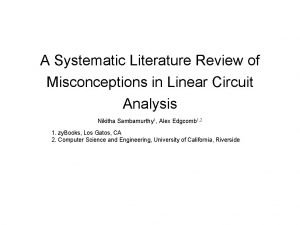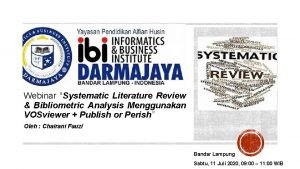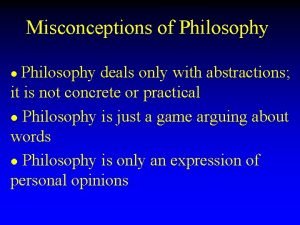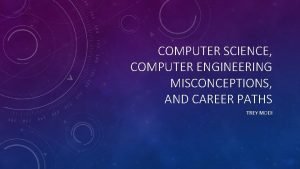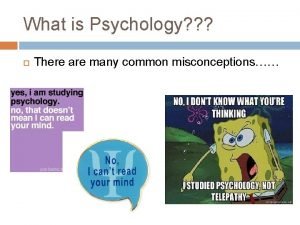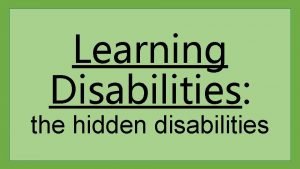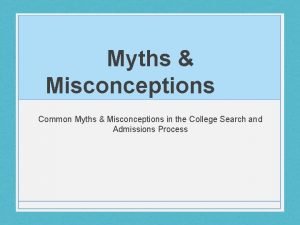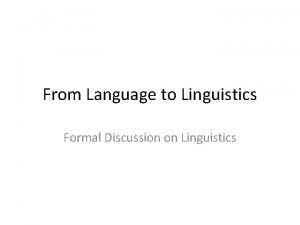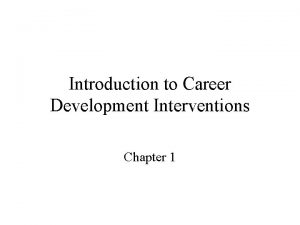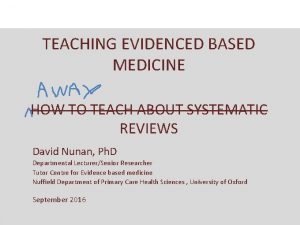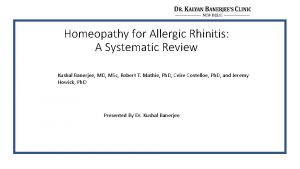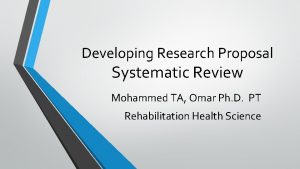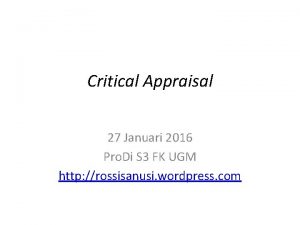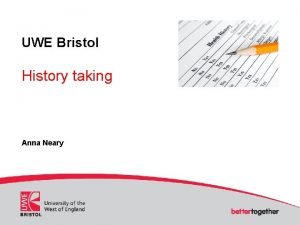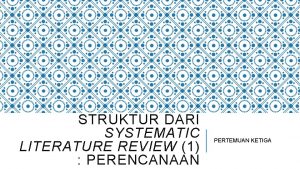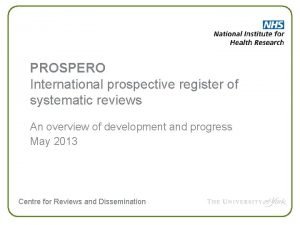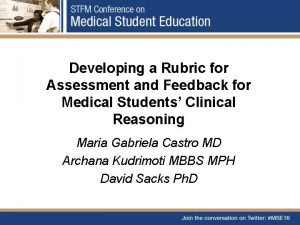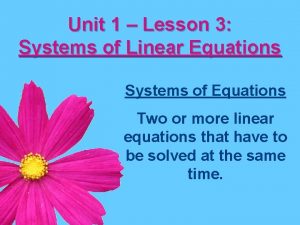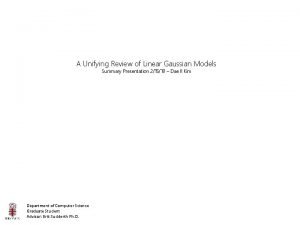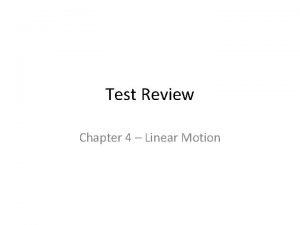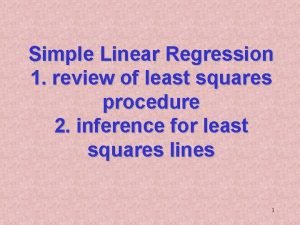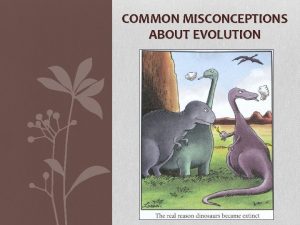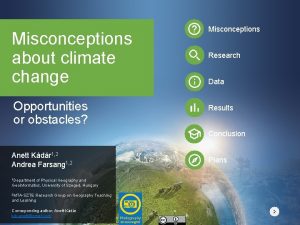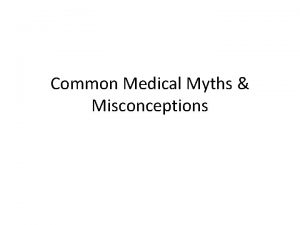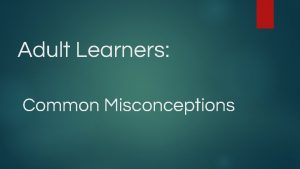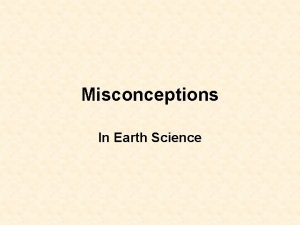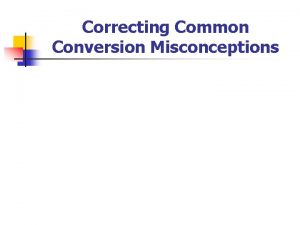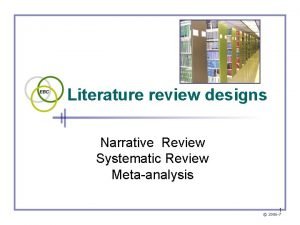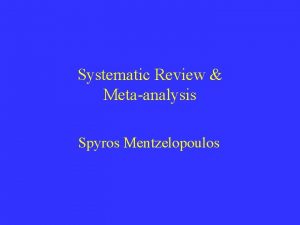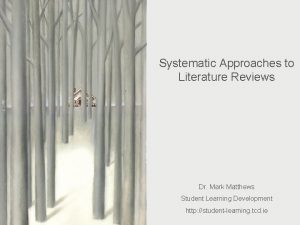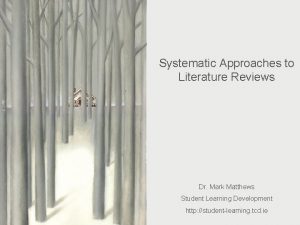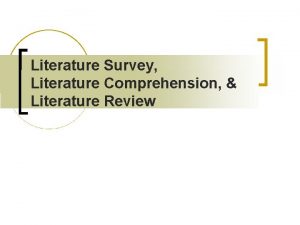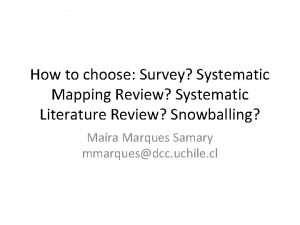A Systematic Literature Review of Misconceptions in Linear





![Literature Search 93 articles 72 irrelevant 6 inaccessible [7] [9] [10] [13] [15] [17] Literature Search 93 articles 72 irrelevant 6 inaccessible [7] [9] [10] [13] [15] [17]](https://slidetodoc.com/presentation_image_h/093455bbb32f09871fbbf5805576ae0d/image-6.jpg)

![Where did assessments come from? [17] [15] Validated assessments Where did assessments come from? [17] [15] Validated assessments](https://slidetodoc.com/presentation_image_h/093455bbb32f09871fbbf5805576ae0d/image-8.jpg)
![Where did assessments come from? [17] [15] Validated assessments [20] [19] [18] In-house assessments Where did assessments come from? [17] [15] Validated assessments [20] [19] [18] In-house assessments](https://slidetodoc.com/presentation_image_h/093455bbb32f09871fbbf5805576ae0d/image-9.jpg)
![Where did assessments come from? [17] [15] Validated assessments [20] [19] [18] [23] [9] Where did assessments come from? [17] [15] Validated assessments [20] [19] [18] [23] [9]](https://slidetodoc.com/presentation_image_h/093455bbb32f09871fbbf5805576ae0d/image-10.jpg)
![Where did assessments come from? [17] [15] Validated assessments [20] [19] [18] [23] [9] Where did assessments come from? [17] [15] Validated assessments [20] [19] [18] [23] [9]](https://slidetodoc.com/presentation_image_h/093455bbb32f09871fbbf5805576ae0d/image-11.jpg)
![Types of Assessment [7] [18] [19] [20] [23] [24] [26] [28] [27] [9] [13] Types of Assessment [7] [18] [19] [20] [23] [24] [26] [28] [27] [9] [13]](https://slidetodoc.com/presentation_image_h/093455bbb32f09871fbbf5805576ae0d/image-12.jpg)












![Specific Math Misconceptions • Algebra manipulations : Incorrect solving of algebra equation [19][20] • Specific Math Misconceptions • Algebra manipulations : Incorrect solving of algebra equation [19][20] •](https://slidetodoc.com/presentation_image_h/093455bbb32f09871fbbf5805576ae0d/image-25.jpg)






![References [3] T. Ogunfunmi and M. Rahman, “A concept inventory for an Electric Circuits References [3] T. Ogunfunmi and M. Rahman, “A concept inventory for an Electric Circuits](https://slidetodoc.com/presentation_image_h/093455bbb32f09871fbbf5805576ae0d/image-32.jpg)
![[19] Smaill, C. , Rowe, G. , and Godfrey, E. What Do They Know? [19] Smaill, C. , Rowe, G. , and Godfrey, E. What Do They Know?](https://slidetodoc.com/presentation_image_h/093455bbb32f09871fbbf5805576ae0d/image-33.jpg)
- Slides: 33

A Systematic Literature Review of Misconceptions in Linear Circuit Analysis Nikitha Sambamurthy 1, Alex Edgcomb 1, 2 1. zy. Books, Los Gatos, CA 2. Computer Science and Engineering, University of California, Riverside

TL; DL (Too Long; Didn’t Listen) 1. Need for research that experimentally addresses linear circuit analysis misconceptions. 2. Many misconceptions stem from physics misconceptions. We suggest focusing on addressing physics misconceptions first.

Why care about misconceptions? Addressing student misconceptions is critical to learning.

Misconception Example Students can take water analogies literally, believing electrons will pool behind resistors like water pools behind a dam.

Literature Search misconceptions "circuit analysis" "electrical engineering" "first-year" -electrochemistry
![Literature Search 93 articles 72 irrelevant 6 inaccessible 7 9 10 13 15 17 Literature Search 93 articles 72 irrelevant 6 inaccessible [7] [9] [10] [13] [15] [17]](https://slidetodoc.com/presentation_image_h/093455bbb32f09871fbbf5805576ae0d/image-6.jpg)
Literature Search 93 articles 72 irrelevant 6 inaccessible [7] [9] [10] [13] [15] [17] [18] [19] [20] [23] [24] [26] [27] [28] [29]

What methods has the community used to investigate and address misconceptions?
![Where did assessments come from 17 15 Validated assessments Where did assessments come from? [17] [15] Validated assessments](https://slidetodoc.com/presentation_image_h/093455bbb32f09871fbbf5805576ae0d/image-8.jpg)
Where did assessments come from? [17] [15] Validated assessments
![Where did assessments come from 17 15 Validated assessments 20 19 18 Inhouse assessments Where did assessments come from? [17] [15] Validated assessments [20] [19] [18] In-house assessments](https://slidetodoc.com/presentation_image_h/093455bbb32f09871fbbf5805576ae0d/image-9.jpg)
Where did assessments come from? [17] [15] Validated assessments [20] [19] [18] In-house assessments
![Where did assessments come from 17 15 Validated assessments 20 19 18 23 9 Where did assessments come from? [17] [15] Validated assessments [20] [19] [18] [23] [9]](https://slidetodoc.com/presentation_image_h/093455bbb32f09871fbbf5805576ae0d/image-10.jpg)
Where did assessments come from? [17] [15] Validated assessments [20] [19] [18] [23] [9] In-house assessments Class/Lab assessments
![Where did assessments come from 17 15 Validated assessments 20 19 18 23 9 Where did assessments come from? [17] [15] Validated assessments [20] [19] [18] [23] [9]](https://slidetodoc.com/presentation_image_h/093455bbb32f09871fbbf5805576ae0d/image-11.jpg)
Where did assessments come from? [17] [15] Validated assessments [20] [19] [18] [23] [9] [10] In-house assessments Class/Lab assessments Textbook Analysis
![Types of Assessment 7 18 19 20 23 24 26 28 27 9 13 Types of Assessment [7] [18] [19] [20] [23] [24] [26] [28] [27] [9] [13]](https://slidetodoc.com/presentation_image_h/093455bbb32f09871fbbf5805576ae0d/image-12.jpg)
Types of Assessment [7] [18] [19] [20] [23] [24] [26] [28] [27] [9] [13] [15] [29] Diagnostic assessments Interviews Both

Findings 1 Need for research addressing misconceptions.

What are the misconceptions?

Categories of Misconceptions* MATH 2* Use of algebraic manipulations.

Categories of Misconceptions* MATH PHYSICS 2* 5* Failure to understand conservation of charge.

Categories of Misconceptions* MATH PHYSICS AC CIRCUITS 2* 5* 2* Confusion in identifying what is alternating.

Categories of Misconceptions* ELEMENTS IN SERIES & PARALLEL 2* MATH PHYSICS AC CIRCUITS 2* 5* 2* Misidentifying components in series & parallel.

Categories of Misconceptions* MATH PHYSICS AC CIRCUITS 2* 5* 2* ELEMENTS IN SERIES & PARALLEL APPLICATION OF OHM’S LAW 2* 2* Blind reliance on Ohm’s Law.

Categories of Misconceptions* MATH PHYSICS AC CIRCUITS 2* 5* 2* ELEMENTS IN SERIES & PARALLEL APPLICATION OF OHM’S LAW 2* 2* OPEN & SHORT CIRCUITS 4* Confusing open/closed circuits as on/off.

Categories of Misconceptions* MATH PHYSICS AC CIRCUITS 2* 5* 2* ELEMENTS IN SERIES & PARALLEL APPLICATION OF OHM’S LAW 2* 2* OPEN & SHORT CIRCUITS KIRCHOFF’S CIRCUIT LAWS 4* 2* Believing mesh current directions matter.

Categories of Misconceptions* MATH PHYSICS AC CIRCUITS 2* 5* 2* ELEMENTS IN SERIES & PARALLEL APPLICATION OF OHM’S LAW 2* 2* OPEN & SHORT CIRCUITS KIRCHOFF’S CIRCUIT LAWS 4* 2* SEQUENTIAL REASONING 1* Failure to consider changes in whole circuit.

Categories of Misconceptions* MATH PHYSICS AC CIRCUITS 2* 5* 2* ELEMENTS IN SERIES & PARALLEL APPLICATION OF OHM’S LAW 2* 2* OPEN & SHORT CIRCUITS KIRCHOFF’S CIRCUIT LAWS 4* 2* SEQUENTIAL REASONING 1* explicit concept dependency concepts in conjunction

Categories of Misconceptions* MATH PHYSICS AC CIRCUITS 2* 5* 2* ELEMENTS IN SERIES & PARALLEL APPLICATION OF OHM’S LAW 2* 2* OPEN & SHORT CIRCUITS KIRCHOFF’S CIRCUIT LAWS 4* 2* SEQUENTIAL REASONING 1*
![Specific Math Misconceptions Algebra manipulations Incorrect solving of algebra equation 1920 Specific Math Misconceptions • Algebra manipulations : Incorrect solving of algebra equation [19][20] •](https://slidetodoc.com/presentation_image_h/093455bbb32f09871fbbf5805576ae0d/image-25.jpg)
Specific Math Misconceptions • Algebra manipulations : Incorrect solving of algebra equation [19][20] • Calculus manipulations : Believe sinusoidal means sine, calculating wrong cosine angles [7]

Misconception Categories MATH PHYSICS AC CIRCUITS 2* 5* 2* ELEMENTS IN SERIES & PARALLEL APPLICATION OF OHM’S LAW 2* 2* OPEN & SHORT CIRCUITS KIRCHOFF’S CIRCUIT LAWS 4* 2* SEQUENTIAL REASONING 1*

Misconception Categories MATH PHYSICS AC CIRCUITS 2* 5* 2* ELEMENTS IN SERIES & PARALLEL APPLICATION OF OHM’S LAW 2* 2* OPEN & SHORT CIRCUITS KIRCHOFF’S CIRCUIT LAWS 4* 2* SEQUENTIAL REASONING 1*

Specific Physics Misconceptions • Charge as a property of matter: Electrons carry positive charge [7]; voltage source provides charge [10] • Conservation of charge : Charge is used up in a circuit [10]; current is used up in a circuit [23][24][26]; voltage is used up in a circuit [23] • Electric fields and voltage : Voltage source supplies current [10][24][26][27]; battery supplies the voltage source which causes current [27] • Term confusion : Current related to potential energy [7][27]; voltage and current switch on and off, or positive and negative [9]; current and voltage are confused [26]; current/resistance are confused [26]; voltage is (or like) current that flows or moves [27]; voltage is measure of strength/ size/force of current [27]; voltage is pressure [27] • Incomplete metaphor : Current is like water that flows through a pipe [9][10][27]; that metaphor yielded a particular misconception: current pools behind resistors [27]

Misconception Categories MATH PHYSICS AC CIRCUITS 2* 5* 2* ELEMENTS IN SERIES & PARALLEL APPLICATION OF OHM’S LAW 2* 2* OPEN & SHORT CIRCUITS KIRCHOFF’S CIRCUIT LAWS 4* 2* SEQUENTIAL REASONING 1*

Conclusion 2 Physics: focus on addressing misconceptions. Math: also foundational.

Conclusion • Need research addressing misconceptions • Focus on physics (and math) • Future work: Expand literature search, experiments addressing misconceptions
![References 3 T Ogunfunmi and M Rahman A concept inventory for an Electric Circuits References [3] T. Ogunfunmi and M. Rahman, “A concept inventory for an Electric Circuits](https://slidetodoc.com/presentation_image_h/093455bbb32f09871fbbf5805576ae0d/image-32.jpg)
References [3] T. Ogunfunmi and M. Rahman, “A concept inventory for an Electric Circuits course : Rationale and fundamental topics, ” in Proceedings of 2010 IEEE International Symposium on Circuits and Systems, pp. 2804– 2807, 2010. [4] Wang, Tianyu, and Thomas Andre. "Conceptual change text versus traditional text and application questions versus no questions in learning about electricity. " Contemporary educational psychology 16, no. 2: 103 -116, 1991. [5] Engelhardt, P. V, and Beichner, R. J. Students' understanding of direct current resistive electrical circuits. Am. J. Phys. , 72, 98 -115, 2004. [6] Kapartzianis, A. , and Kriek, J. Conceptual Change Activities Alleviating Misconceptions about Electrical Circuits. Journal of Baltic Science Education, 13(3), 2014. [7] Bull, S. , Jackson, T. J. , and Lancaster, M. J. Students' interest in their misconceptions in first-year electrical circuits and mathematics courses. International Journal of Electrical Engineering Education, 47(3), 307 -318, 2010. [8] Koontse, R. D. The role of mathematics in first year students’ understanding of electricity problems in physics (Doctoral dissertation), 2015. [9] Biswas, G. , Schwartz, D. , Bhuva, B. , Bransford, J. , and Brophy, S. . Analysis of student understanding of basic AC concepts (No. TR-CS 98 -07). Vanderbilt University, Nashville, TN. Learning Technology Center, 1998. [10] Sangam, D. , and Jesiek, B. K. Conceptual gaps in circuits textbooks: A comparative study. IEEE Transactions on Education, 58(3), 194202, 2015. [11] Helgeland, B. and D. Rancour. Circuits Concept Inventory. http: //www. foundationcoalition. org/home/keycomponents/concept/circuits. html. Accessed: February, 2018. [12] Lee, C. S. , N. J. Mc. Neill, E. P. Douglas, M. E. Koro-Ljungberg, and D. J. Therriault, “Indispensable Resource? A Phenomenological
![19 Smaill C Rowe G and Godfrey E What Do They Know [19] Smaill, C. , Rowe, G. , and Godfrey, E. What Do They Know?](https://slidetodoc.com/presentation_image_h/093455bbb32f09871fbbf5805576ae0d/image-33.jpg)
[19] Smaill, C. , Rowe, G. , and Godfrey, E. What Do They Know? : An Entry-level Test for Electricity. In 19 th Annual Conference of the Australasian Association for Engineering Education: To Industry and Beyond; Proceedings of the (p. 373). Institution of Engineers, Australia, 2008. [20] Smaill, C. R. , Rowe, G. B. , Godfrey, E. , and Paton, R. O. An investigation into the understanding and skills of first-year electrical engineering students. IEEE Transactions on Education, 55(1), 29 -35, 2012. [21] Ding, L. , Chabay, R. , Sherwood, B. and Beichner, R. Evaluating an assessment tool: Brief electricity and magnetism assessment. Phys. Rev. ST PER 2(1), 10105 -1 to 10105 -7, 2006. [22] Maloney, D. , O’Kuma, T. , Hieggelke C. and Van Heuvelen, A. Surveying students’ conceptual knowledge of electricity and magnetism. PERS of Am. J. Phys. , 69(7), S 12, 2001. [23] Turner, M. J. Evaluation of an Early Three Phase Approach to Electric Circuit Instruction. International Journal of Engineering Pedagogy, 7(1), 2017. [24] Des. Portes, K. , Anupam, A. , Pathak, N. , and Di. Salvo, B. Circuit diagrams vs. physical circuits: The effect of representational forms during assessment. In Frontiers in Education Conference (FIE), 2016 IEEE (pp. 1 -9). IEEE, October, 2016. [25] Evans, D. L. , Gray, G. L. , Krause, S. , Martin, J. , Midkiff, C. , Notaros, B. M. , . . . and Streveler, R. Progress on concept inventory assessment tools. In Frontiers in Education, 2003. FIE 2003 33 rd Annual (Vol. 1, pp. T 4 G-1). IEEE, November, 2003. [26] Whitesel, C. A. Relationships Among Personal Characteristics, Self-Efficacy, and Conceptual Knowledge of Circuit Analysis of Community College Engineering Students. Arizona State University, 2014. [27] Bledsoe, K. E. How do engineering students develop and reason with concepts of electricity within a project-based course? . Oregon State
 Misconceptions about literature review
Misconceptions about literature review Narrative review vs systematic review
Narrative review vs systematic review Traditional and systematic review venn diagram
Traditional and systematic review venn diagram Narrative review vs systematic review
Narrative review vs systematic review Literature review dalam penelitian
Literature review dalam penelitian Misconceptions about force and motion
Misconceptions about force and motion Philosophy study of knowledge
Philosophy study of knowledge Common misconceptions about computer science
Common misconceptions about computer science Anime outline naruto
Anime outline naruto Common psychology misconceptions
Common psychology misconceptions Misconceptions about learning disabilities
Misconceptions about learning disabilities Misconceptions of multicultural education
Misconceptions of multicultural education Forumlaic
Forumlaic Participants in a formal discussion use language that is
Participants in a formal discussion use language that is Introduction to career development
Introduction to career development Qfas systematic review
Qfas systematic review Dr. kushal banerjee
Dr. kushal banerjee Prospero systematic review
Prospero systematic review Systematic review research proposal
Systematic review research proposal Statistik inferensial menurut para ahli
Statistik inferensial menurut para ahli Presenting complaint
Presenting complaint Struktur literature review
Struktur literature review Prospero systematic review
Prospero systematic review Systematic review in history taking
Systematic review in history taking Chapter review motion part a vocabulary review answer key
Chapter review motion part a vocabulary review answer key Uncontrollable spending ap gov
Uncontrollable spending ap gov Lesson 3 linear equations in x
Lesson 3 linear equations in x A unifying review of linear gaussian models
A unifying review of linear gaussian models Chapter 4 test linear motion answer key
Chapter 4 test linear motion answer key Linear regression review
Linear regression review Simple and multiple linear regression
Simple and multiple linear regression Persamaan non linier metode biseksi
Persamaan non linier metode biseksi Linear texts
Linear texts Non linear narrative definition
Non linear narrative definition
